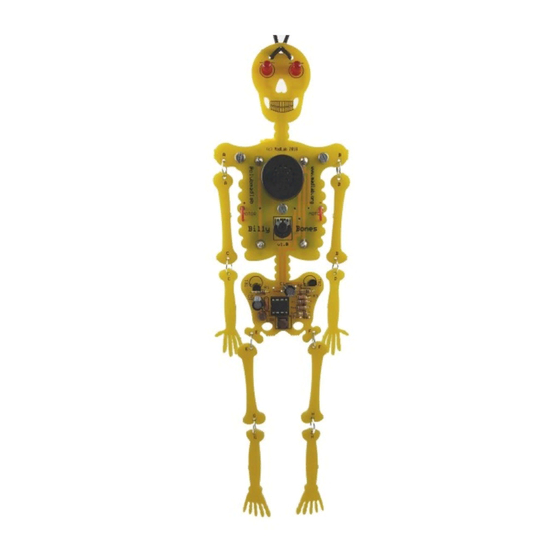
Advertisement
Table of Contents
Billy Bones
Billy Bones is a seasonal kit in the shape of an articulated skeleton suspended by an elastic cord that laughs
maniacally and 'dances' when triggered. It is sensitive to light and can be left in a darkened room for example
where it will be triggered by someone entering the room and turning the light on.
Construction
First separate the circuit board into its individual component parts (main board + smaller 'backpack' board + 8
limb bones). They can be snapped at the 'mouse bites' by hand or by using pliers. File or sand smooth the
remains of the mouse bites if desired.
Fit and solder the resistors (R1 to R6) to the main circuit board and trim their legs. Identify the resistors by the
coloured stripes on the body.
Next fit the chip socket (IC1) matching the notch in the socket against the notch in the symbol on the board.
Care should be taken when soldering this component to avoid solder bridges between the pins. It is not
recommended that the chip is soldered directly to the board.
Fit and solder the capacitors paying attention to the polarity of the electrolytics C1 and C2 (negative is marked
by the shorter leg and a stripe on the side of the body). The ceramic capacitor (C3) can be fitted either way
around. (Note that the remaining ceramic capacitor is soldered later to the motor.)
Solder the two LEDs to the skull matching the shorter leg (also flat on the rim) to the hole with the line.
Solder the pushbutton (S1), the variable resistor (VR1) and the speaker (SPEAKER).
Solder the light-dependent resistor (LDR) either way around. Be careful not to apply too much heat as it may
damage the component.
Solder the two transistors (TR1 and TR2) matching the shape to the symbol on the board. Note that the two
transistors are different from each other. They can be differentiated by the marking on the side.
Fit the two battery holders to the back of the main board paying attention to their polarity. The spring ends of
the battery holders are negative (–) and should be closer to the skull. Solder the leads to the front of the board.
Don't fit the chip into its socket until you have thoroughly checked your construction. Check that all the
components have been inserted correctly and that there are no dry joints and no solder bridges between pins.
Then match the small notch in the chip to the notch in its socket.
Push the spindle firmly into the variable resistor.
At this point it's worth checking that the main board is working properly. Fit a pair of 1.5V AAA cells to the
battery holders observing the correct orientation. It is recommended that good quality alkaline cells are used. If
the board is functioning correctly the LEDs should flash twice and the speaker should beep. Remove the cells if
all is well.
The next stage is to assemble the motor backpack and attach it to the main board. Solder the two flexible wires
to the motor terminals along with the remaining capacitor using the sleeving to insulate the capacitor's legs
(see photo below).
Advertisement
Table of Contents

Summary of Contents for MadLab Billy Bones
- Page 1 Billy Bones Billy Bones is a seasonal kit in the shape of an articulated skeleton suspended by an elastic cord that laughs maniacally and ‘dances’ when triggered. It is sensitive to light and can be left in a darkened room for example where it will be triggered by someone entering the room and turning the light on.
- Page 2 The LDR reacts to changes in light level and acts as a simple light or motion sensor. The variable resistor sets its sensitivity (clockwise = less sensitive). When Billy Bones is triggered by, for example, a room light being switched on it flashes its eyes, plays a manic laughing sound effect, spins the motor and dances.
- Page 5 3 jump ring x 8 self-tapping screw x 4 washer x 16 elastic cord, 50cm (black) pre-cut wire x 2 sleeving (grey) x 2 Design and documentation © MadLab Ltd. 2019 Email: info@madlab.org Web: www.madlab.org Twitter/Instagram: @clubmadlab...


Need help?
Do you have a question about the Billy Bones and is the answer not in the manual?
Questions and answers